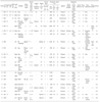1. Rodriguez-Hermosa JI, Codina-Cazador A, Maroto-Genover A, Puig-Alcantara J, Sirvent-Calvera JM, Garsot-Savall E, et al. Obturator hernia: clinical analysis of 16 cases and algorithm for its diagnosis and treatment. Hernia. 2008. 12:289–297.
2. Kim HA, Lee RA, Kim KH. Obturator hernia which was combined with inguinal hernia and hiatal hernia. J Korean Surg Soc. 2005. 68:168–171.
3. Zinner MJ, Schwartz SI, Ellis H. Maingot's Abdominal Operations. 1997. 10th ed. Stamford: Appleton & Lange;540–542.
4. Park CY, Kim JC, Choi SJN, Kim SK. Incarcerated obturator hernia: the need of herniorrhaphy in self-reduced obturator hernia. J Korean Surg Soc. 2009. 76:192–198.
5. Kammori M, Mafune K, Hirashima T, Kawahara M, Hashimoto M, Ogawa T, et al. Forty-three cases of obturator hernia. Am J Surg. 2004. 187:549–552.
6. Haraguchi M, Matsuo S, Kanetaka K, Tokai H, Azuma T, Yamaguchi S, et al. Obturator hernia in an ageing society. Ann Acad Med Singapore. 2007. 36:413–415.
7. Hwang KT, Chung JK, Jung IM, Heo SC, Ahn YJ, Chang MS. Successfully treated obturator hernia in spite of delayed operation. J Korean Surg Soc. 2009. 77:211–215.
8. Choi SI, Joo SH. Totally extraperitoneal laparoscopic repair of obturator hernia with partial intestinal obstruction. J Korean Surg Soc. 2008. 75:415–417.
9. Kim YH, Lim DH, Kim BS, Hwang YH, Jeong YH. Small bowel obstruction due to incarcerated obturator hernia. J Korean Surg Soc. 2006. 71:73–78.
10. Bae JD, Bae JM, Bae TS, Choi EA, Jung HG, Jung KH, et al. Strangulated obturator hernia: mesh-plug technique. J Korean Surg Soc. 2004. 66:438–443.
11. Choi HJ, Choi D, Kim HJ, Lee KG, Kwon OJ, Lee HW, et al. Recurrent strangulated obturator hernia. J Korean Surg Soc. 2002. 63:509–512.
12. Chang SJ, Lee CH, Choi SH, Yun JY, Ahn CH, Kim NI, et al. Preoperative diagnosis of strangulated obturator hernia using CT. J Korean Surg Soc. 2001. 61:216–219.
13. Yoon YD. Strangulated obturator hernia. J Korean Surg Soc. 1998. 54:1038–1041.
14. Kim SY, Chung JS, Kim HC, Kim IY. A case of strangulted obturator hernia. J Korean Surg Soc. 1995. 49:146–151.
15. Lee MS, Wang HJ, Kim HY, Paik IW, Lee HS. Obturator hernia: three cases report. J Korean Surg Soc. 1994. 46:887–897.
16. Park YS, Kim YI, Jun KY. Strangulated obturator hernia. J Korean Surg Soc. 1991. 40:132–135.
17. Kang YS, Son JM, Son JH. Strangulated obturator hernia. J Korean Surg Soc. 1987. 33:116–119.
18. Kwon TW, Jun KY, Cho OK, Kim SY. A case of strangulated obturator hernia. J Korean Surg Soc. 1987. 33:756–759.
19. Choi KH, Yang HJ. Strangulated obturator hernia. J Korean Surg Soc. 1987. 32:723–726.
20. Suh SH, Suh SJ, Nam SH, Lee SS. Strangulated obturator hernia. J Korean Surg Soc. 1968. 10:35–38.
21. Kim MY, Park CS, Kim KR, Shin YW, Oh ST, Suh CH, et al. CT diagnosis of intestinal obstruction: findings and usefulness. J Korean Radiol Soc. 1994. 30:875–880.
22. Skandalakis LJ, Androulakis J, Colborn GL, Skandalakis JE. Obturator hernia. Embryology, anatomy, and surgical applications. Surg Clin North Am. 2000. 80:71–84.
23. Schmidt PH, Bull WJ, Jeffery KM, Martindale RG. Typical versus atypical presentation of obturator hernia. Am Surg. 2001. 67:191–195.
24. Bergstein JM, Condon RE. Obturator hernia: current diagnosis and treatment. Surgery. 1996. 119:133–136.








 PDF
PDF ePub
ePub Citation
Citation Print
Print



 XML Download
XML Download